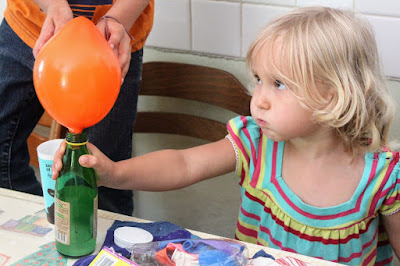As I've documented before part of our science curriculum is covered by the science group the children belong to, a spin off from Les Petits Debrouillards (the little do it them selfers is the best translation I can come up with) but that doesn't stop us from repeating experiments at home and also doing our own.
Last week Lotta did some chemistry with bicarbonate of soda (alkaline) and vinegar (acid). The first part of the experiment involved mixing the two together and observing what happened.
The second part was a challenge - take the bicarb, the vinegar, a small bottle and a balloon and inflate and keep inflated the balloon without using air.
First of all we talked again about what had happened when we mixed vinegar and baking soda. How it made lots of bubbles which were filled with gas. We talked about how we could get this gas into a balloon. We tried a few things. If we just mixed them together we did blow the balloon up but it was tiny. We worked out that was because the gas was escaping before we attached the balloon to the bottle.
Finally we decided to put the vinegar in one receptacle, the bottle, and the bicarbonate in the other, the balloon. We then attached the balloon to the bottle and gave the whole thing a shake. Bingo! The balloon inflated and stayed inflated.
Afterwards we detached the balloon and tied a knot in it. Lotta and her brother both observed that it didn't float up into the air a bit like a normal balloon but quickly sank to the ground which enabled us to talk about the gas produced being heavier than air.
All in all this was great fun and enabled us to touch on some important principles of the physical world.
Top tips for experimenting with children
- Let them do as much as possible, it's not as fun to watch.
- Have the kids gather the materials you'll need where at all possible.
- Try to resist edging them towards the right solutions, you can learn a lot from trial and error and this is one of the founding principles of all scientific process.
- Encourage them to be observant. Questions like what do you see? what's happening? are good prompts.
- Repeat as many times as they want if you're able to. In my experience if they're asking to do something again it's that they still have something to learn from it even if you feel they've 'got it'. This is also true if they ask to do something again months or even years later. Perhaps in the meantime they've acquired new knowledge that will fuel their understanding of what's happening.
- Challenges are a fun way to get the kids doing it themselves and trying out different things.
- If you're working with more than one child they can each try their own way either at the same time or successively. This is a good way for kids to see how other people think and problem solve.





No comments:
Post a Comment